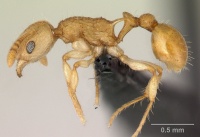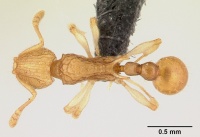Vitsika disjuncta
| Vitsika disjuncta | |
|---|---|

| |
| Scientific classification | |
| Kingdom: | Animalia |
| Phylum: | Arthropoda |
| Class: | Insecta |
| Order: | Hymenoptera |
| Family: | Formicidae |
| Subfamily: | Myrmicinae |
| Tribe: | Crematogastrini |
| Genus: | Vitsika |
| Species: | V. disjuncta |
| Binomial name | |
| Vitsika disjuncta Bolton & Fisher, 2014 | |
All material of this species was retrieved from litter samples.
Identification
Bolton and Fisher (2014) - This species resembles Vitsika tenuis, but in the vast majority of that species the propodeal spines are strongly downcurved, and the propodeal dorsum lacks the distinctive peak or crest that is present in disjuncta.
Keys including this Species
Distribution
Endemic to Madagascar.
Latitudinal Distribution Pattern
Latitudinal Range: -18.03583333° to -18.03583333°.
| North Temperate |
North Subtropical |
Tropical | South Subtropical |
South Temperate |
- Source: AntMaps
Distribution based on Regional Taxon Lists
Malagasy Region: Madagascar (type locality).
Distribution based on AntMaps
Distribution based on AntWeb specimens
Check data from AntWeb
Countries Occupied
| Number of countries occupied by this species based on AntWiki Regional Taxon Lists. In general, fewer countries occupied indicates a narrower range, while more countries indicates a more widespread species. |

|
Estimated Abundance
| Relative abundance based on number of AntMaps records per species (this species within the purple bar). Fewer records (to the left) indicates a less abundant/encountered species while more records (to the right) indicates more abundant/encountered species. |

|
Biology
Castes
Males have yet to be collected.
Worker
Images from AntWeb
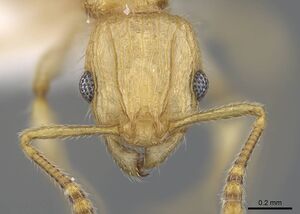   
| |
| Holotype of Vitsika disjuncta. Worker. Specimen code casent0248547. Photographer Michele Esposito, uploaded by California Academy of Sciences. | Owned by CAS, San Francisco, CA, USA. |
Queen
Images from AntWeb
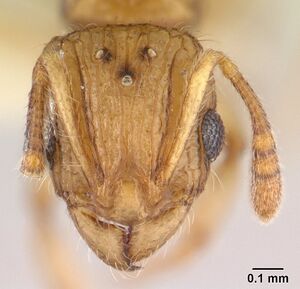   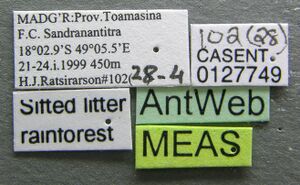
| |
| Queen (alate/dealate). Specimen code casent0127749. Photographer Erin Prado, uploaded by California Academy of Sciences. | Owned by CAS, San Francisco, CA, USA. |
Nomenclature
The following information is derived from Barry Bolton's Online Catalogue of the Ants of the World.
- disjuncta. Vitsika disjuncta Bolton & Fisher, 2014: 79, figs. 93-95, Map 153 (w.q.) MADAGASCAR.
Unless otherwise noted the text for the remainder of this section is reported from the publication that includes the original description.
Description
Worker
(holotype in parentheses). TL 2.5–3.1 (2.9), HL 0.56–0.65 (0.62), HW 0.48–0.55 (0.53), CI 84–86 (85), SL 0.40–0.46 (0.46), SI 83–88 (87), PW 0.36–0.44 (0.40), WL 0.70–0.84 (0.82) (8 measured).
Eye with 6–7 rows of ommatidia, and with 8–9 ommatidia in the longest row; EL 0.15–0.16 (EL/HW 0.29–0.31). MfL 0.48–0.58 (MfL/HW 1.00–1.05). In profile, the dorsal outline of the propodeum rises to a markedly raised peak or angle posterior to the site of the metanotal groove, then descends abruptly and steeply to the dorsal base of the propodeal spine. Propodeal spines in profile slender, slightly elevated, weakly curved. Diameter of annulus of propodeal spiracle is at least equal to the thickness of the propodeal spine at its midlength. Petiole node in profile small, subcuneate, erect or slightly curved anteriorly with respect to the peduncle; very narrowly rounded dorsally, and entirely unsculptured. Anterior face of petiole node vertical or slightly concave to the anterodorsal angle; the dorsal and posterior faces form a single, even curve behind the angle. Height of petiole node in posterior view (from midpoint of the dorsal margin of the foramen to the apex) 0.90–1.00 × its maximum width. In dorsal view postpetiole 1.14–1.24 × broader than long; maximum width of postpetiole 0.92–1.00 × the length of a propodeal spine; maximum width of postpetiole 0.88–0.96 × the distance between the apices of the propodeal spines. Length of postpetiole node in profile slightly less than the height of the segment. Disc of postpetiole entirely smooth, glossy. Full adult colour yellow.
Queen
(gyne). Only a single alate known. HL 0.67, HW 0.59, CI 88, SL 0.47, SI 80, PW 0.52, WL 0.92, maximum width of mesoscutum 0.46, maximum length of mesoscutum 0.46, MfL 0.58. Propodeal spines long and slender, very slightly downcurved, almost horizontal.
Type Material
Holotype worker, Madagascar: Prov. Toamasina, F.C. Sandranantitra, 18°02.9’S, 49°05.5’E, 450 m., 18–21.i.1999, sifted litter (leaf mold, rotten wood), rainforest, #101(15)-5 (H.J. Ratsirarson) (California Academy of Sciences). Paratypes. 3 workers on a single pin, with same data as holotype but #101(21); 3 workers on a single pin with same data but #101(21)-4 (CASC).
References
- Bolton, B. & Fisher, B.L. 2014. The Madagascan endemic myrmicine ants related to Eutetramorium (Hymenoptera: Formicidae): taxonomy of the genera Eutetramorium Emery, Malagidris nom. n., Myrmisaraka gen. n., Royidris gen. n., and Vitsika gen. n. Zootaxa 3791:1–99. doi:10.11646/zootaxa.3791.1.1
